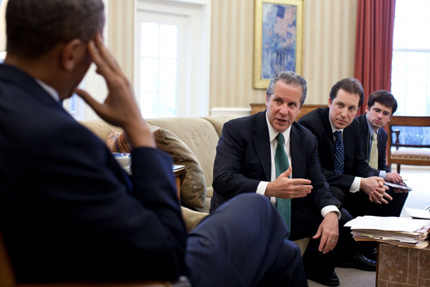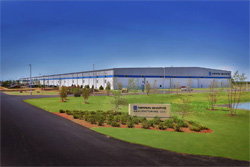|
The mission of the Economic Development Administration (EDA) is to lead the federal economic development agenda by promoting innovation and competitiveness, preparing American regions for growth and success in the worldwide economy. The agency has a competitive grant process and has established the following investment priorities as criteria: collaborative regional innovation, public/private partnerships, national strategic priorities, global competitiveness, environmentally sustainable development, and economically distressed and underserved communities.
Q&A: Advancing the U.S. Manufacturing Sector—The Last Four Years
 |
Jason Miller, (second from left) special assistant to the president for manufacturing
policy, with members of the National Economic Council as they
meet with President Obama. |
Jason Miller is the special assistant to the president for manufacturing policy, working within the National Economic Council in the White House. He leads the administration’s efforts to coordinate policy and federal activities supporting U.S. manufacturing. EDA has a strong, ongoing partnership with these efforts, and this past November Miller spoke at EDA’s senior leadership retreat in Washington, D.C. Mr. Miller joined the Obama administration in April 2010. Prior to joining the administration, he advised global companies as a management consultant with The Boston Consulting Group and Marakon Associates.
Mr. Miller recently answered some questions about the administration’s manufacturing policy and the prospects for a revitalized American manufacturing sector and the benefits that will bring to the U.S. economy and the middle class.
Q: In your capacity at the White House you focus on manufacturing policy, which is a major priority for President Obama. What are some of the administration's biggest accomplishments in advancing the U.S. manufacturing sector over the last four years?
A: When the president came into office in January 2009, he faced an economic crisis unlike anything our country had experienced in three generations, a crisis that included an auto industry on the brink of collapse. As part of the President’s efforts to combat the crisis, he made a difficult decision to provide federal support to GM and Chrysler through a restructuring, committing funding so long as they and all stakeholders were willing to make difficult decisions to restructure their businesses. Experts had estimated that over one million jobs would have been lost all across the country if GM and Chrysler had been allowed to go under. We all now know how the story ended, with the auto industry adding more than 250,000 jobs since the companies emerged from bankruptcy in June 2009.
The decision to rescue the auto industry was critical in stemming the crisis and returning the economy to growth and job creation. But it was also an important learning moment for our country. In that moment, we recognized the ripple effects that could occur if we had lost our auto industry, rippling through the webs of suppliers and communities that rely on those companies. We learned that our manufacturing operates as part of an integrated system, and the risk that we face can ripple across that system and can be very hard to repair or rebuild.
Since the beginning of 2010, U.S. manufacturing has added 500,000 jobs, the strongest period of manufacturing job growth since 1996. Companies are now increasingly choosing to invest here and we are on the cusp of a renaissance in American manufacturing that would have been unimaginable only a few short years ago. Production, investment, and exports are growing. We still have a long way to go, but once again there is a belief in the strength of American manufacturing.
Q: What can we expect to see in President Obama’s second term to revitalize American manufacturing to strengthen our economy and the middle class?
A: Well, I don’t want to get ahead of the president on his plans going forward, but I can tell you that manufacturing will continue to be a priority for the president and a key part of his economic agenda.
Over the last four years, the president has laid out a broad agenda to revitalize American manufacturing, one that includes competitiveness policies for the entire economy that have strong impacts on manufacturing, including critical investments in infrastructure and R&D, reforming our business tax system to encourage investment in the United States, encouraging safe and responsible natural gas development, investing in workforce skills, both through our community college system and by strengthening STEM education, and ensuring that our trading partners play by the rules. But his agenda also includes much needed sector-specific efforts like spurring advanced vehicle and clean energy manufacturing, strengthening domestic suppliers, and launching a national network of manufacturing innovation institutes. Going forward, we will continue to take steps to implement and build on the president’s vision, and part of that will require us to build on our efforts with regions and communities to strengthen the ecosystems where manufacturing happens.
Q: The U.S. Department of Commerce’s Economic Development Administration (EDA) continues to invest to support economic clusters throughout America’s regions and has leveraged the Jobs and Innovation Accelerator Challenge to jumpstart economic recovery and increase competitiveness. How do these efforts align with NEC’s agenda?
A: By definition manufacturing is a local activity. Studies have clearly shown that manufacturing activity has a set of what we like to call “spillover benefits,” benefits to society that cannot be captured by any one firm. New approaches being demonstrated by EDA and other agencies, like the Jobs and Innovation Accelerator Challenge, are ways that the federal government can, in a coordinated way, take meaningful steps to catalyze the bottom-up strategies needed to strengthen an ecosystem, the complex network of customers, suppliers, workers, universities and research institutes, and community organizations that make manufacturing competitive.
These efforts, where federal agencies work as a partner to strengthen regions and communities, are complementary to our broader policy efforts at a national level. We have a real opportunity over the next several years to compete for manufacturing production, to lay a foundation for a vibrant manufacturing sector and a strong economy for years to come, but that will only be successful and lasting if there are places around the country where that manufacturing can happen.
EDA Success Story
New Manufacturing Plant in Illinois Opens with EDA Help
 EDA was a key player in efforts that led to the recent opening of a new plant in Rochelle, Illinois, for Nippon Sharyo, a Japanese manufacturer of passenger railcars. The company, already active in the U.S. market, will be able to expand its U.S. operations, lower its production costs, comply with the “Made in America” requirements of many of its buyers, and—most important to the local economy—create 250 new jobs. EDA was a key player in efforts that led to the recent opening of a new plant in Rochelle, Illinois, for Nippon Sharyo, a Japanese manufacturer of passenger railcars. The company, already active in the U.S. market, will be able to expand its U.S. operations, lower its production costs, comply with the “Made in America” requirements of many of its buyers, and—most important to the local economy—create 250 new jobs.
This is happening thanks in part to an EDA grant of $2.4 million that was awarded to the city of Rochelle to make improvements to the Rochelle Dual Access Railroad, a short-line railroad that services the industrial park where Nippon Sharyo’s new plant is located. The rail line also serves other companies located there, including Coated Sand Solutions LLC, a resin-coating company affiliate of U.S. Silica Inc.
A strong working partnership between EDA and the city that has existed since at least 1995 has worked to create economic opportunity and jobs in this region. A $3 million EDA grant awarded to Rochelle in 2008, for example, helped to build an overpass that led to the creation of the 2,000 acre industrial area where Nippon Sharyo’s new plant is located.
This history of collaboration is a great example of how good things happen when the right partners in a regional economic ecosystem come together to create jobs and support economic growth.
Spotlight
State of the Union Address: President Obama Launches Plan for a Strong Middle Class and a Strong America
During the State of the Union address on February 12, President Obama outlined a plan that builds on the progress made during his first term and strengthens the middle class by making America a magnet for jobs and manufacturing, equipping every American with the skills they need to do those jobs, and ensuring that hard work leads to a decent living.
A thriving middle class has always been America’s engine of economic growth. Reigniting that engine is the defining challenge of our time.
The plan outlines investments in manufacturing, clean energy, infrastructure, and education to help grow the nation’s economy from the middle class out—not from the top down—and, when combined with the President’s plan for balanced deficit reduction, none of these proposals will add a dime to the deficit.
Click here for a PDF of the President’s plan
Fact Sheet: The President’s Plan to Make America a Magnet for Jobs by Investing in Manufacturing
Click here to read entire fact sheet
EXCERPT:
Investing in manufacturing communities and bringing jobs back: Today, we are better positioned to attract new manufacturing investment in the U.S. and bring jobs back. But some communities are still hard-hit by the recession, particularly after closure of factories in places like Detroit, Michigan and Rochester, New York. The President is announcing new steps to partner with and help strengthen communities, including:
Launching an “Investing in Manufacturing Communities Partnership”: The President is directing Federal agencies to provide coordinated assistance to manufacturing communities through a new partnership designed to strengthen communities’ ability to attract investment. To support the Partnership, the President’s Budget will propose $113 million to provide targeted financial assistance for about five manufacturing communities while leveraging non-Federal funds on a 2 to 1 matching basis to co-invest in state of the art infrastructure projects and research facilities. These efforts will aim to attract manufacturers and their supply chain of local parts innovators, producers, and distributors, creating new jobs and strengthening the local economy. In addition, the Partnership, through multiple Federal agencies, will provide technical support to redevelop manufacturing communities that have had major plant closings, in partnership with local leaders, workers, and businesses.
|

